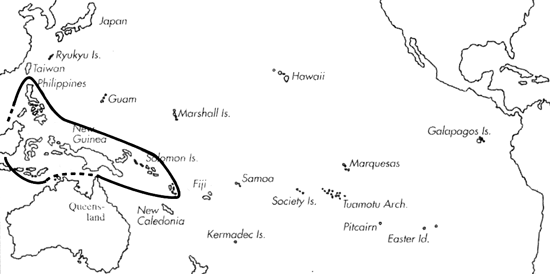Range: Philippines and Indonesia to Papua New Guinea, Solomon Is. and Vanuatu.
Description: Moderately small to medium-sized, moderately solid. Last whorl ventricosely conical; outline convex adapically, less so or straight below. Shoulder subangulate or rounded. Spire usually low, outline variably concave. Larval Shell multispiral, maximum diameter0.7-0.8 mm. Teleoconch sutural ramps flat, with 0-1 increasing to 2-4 spiral grooves, additional spiral striae in latest whorls; sculpture usually weak on last ramp but with a distinct adaxial groove. Last whorl with almost equally spaced axially striate spiral grooves on basal half; ribbons between may turn into groups of ribs towards base.
| Shell Morphometry | ||
|---|---|---|
| L | 30-43 mm | |
| RW | 0.10-0.20 g/mm | |
| RD | 0.53-0.63 | |
| PMD | 0.76-0.84 | |
| RSH | 0.09-0.13 | |
Colour grey or cream white, grading to light brown; juveniles dark brown. Some of these colour tones often blend together both on last whorl and later sutural ramps. Larval whorls grey to beige. Early postnuclear sutural ramps brown. Aperture usually white, or shaded with violet deep within; orange in specimens from Moluccas.
Periostracum dark brown, thin, opaque, and smooth, absent in spiral grooves of last whorl.
Dorsum of foot beige except for white median zone and broad brown transverse band on anterior part; a brown pre-marginal line runs into brown transverse band; black dots on brown band, on anterior median zone and along each side of pre-marginal line. Sole of foot grey to salmon. Rostrum light brown dotted with black. Tentacles brown. Siphon beige, with dorso-lateral clusters of black dots; ventral side white and tip brown. (Pl. 75, Fig. 34; Pl. 79, First row, middle) (Chaberman, pers. comm., 1981).
Habitat and Habits: In 2-20 m, on mud and muddy sand bottoms (Estival, 1981; Chaberman, pers. comm., 1981; Loch, pers. comm., 1992). Subadult C. parius was observed to feed on small fish (Loch, pers. comm., 1992).
Discussion: C. parius is most similar to C. radiatus, which often can be easily separated by its larger size. C. radiatus also differs in its slightly concave later sutural ramps with a stronger spiral sculpture and a pronounced subsutural ridge rather than of a pronounced adaxial groove, and in its darker colouration with a light base and often a contrasting light shoulder band. For comparison with C. cinereus see DISCUSSION of that species. In the Solomon Is. and probably in W. Thailand, shells intermediate in sculpture between C. radiatus and C. pariusoccur (Pl. 18, Fig. 4). These shells resemble C. parius more closely whith respect to morphometry: L 33 - 41 mm RW 0.12 - 0.20 g/mm RD 0.55 - 0.59 PMD 0.77/0.78 RSH 0.09 - 0.12 They differ from both C. parius and C. radiatus in their last whorl pattern of well-separate brown axial streaks and flames on a white ground. Some specimens show traces of a spiral band within the adapical and abapical thirds. We provisionally assign these specimens to C. parius rather than to C. radiatus.

C. parius range map
This section contains verbatim reproductions of the accounts of 316 species of Conus from the Indo-Pacific region, from Manual of the Living Conidae, by Röckel, Korn and Kohn (1995). They are reproduced with the kind permission of the present publisher, Conchbooks.
All plates and figures referred to in the text are also in Röckel, Korn & Kohn, 1995. Manual of the Living Conidae Vol. 1: Indo-Pacific Region.
The range maps have been modified so that each species account has it own map, rather than one map that showed the ranges of several species in the original work. This was necessary because each species account is on a separate page on the website and not confined to the order of accounts in the book.